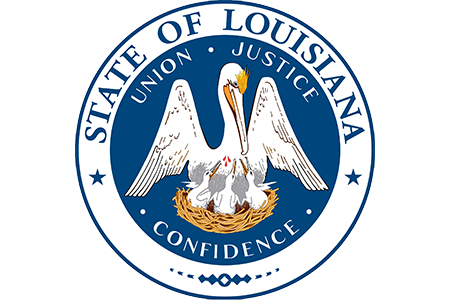The 19th JDC Courthouse is becoming the home for several important pieces of local art. The primary piece is found on the 11th floor and was installed during construction of the courthouse in 2011.
CONRAD ALBRIZIO
Untitled (Elements of Government), 1955
Conrad Albrizio (1894 1973) is best known for the murals he created for public buildings throughout Louisiana, many of which were commissioned during the Great Depression. At that time, the burgeoning political mural movement in Mexico, expedited by artists Diego Rivera and Jose Clemente Orozco, and a renewed interest in the Old Masters inspired the revival of public art in the United States.
In 1954, the State of Louisiana commissioned this mural for the wall of the Louisiana State Capitol that contains bullet holes from the 1935 assassination of Governor Huey P. Long. The mural was never installed due to Governor Earl K. Long’s objections to covering evidence of his brother’s assassination. Eventually completed in 1957, the mural was installed in the Louisiana State Supreme Court building in New Orleans. Damaged by Hurricane Katrina, it was removed in 2008 when the building was demolished. The State of Louisiana ordered the mural’s conservation and in 2011 had it installed on the 11th floor of the 19th Judicial District Court building.
Composed of thousands of fragile, handplaced glass pieces produced in the famous mosaic glassworks of Venice, the mural represents the elements of government, described by Albrizio as “divine inspiration, enlightened man, and force." At the top of the composition are the scales of justice andthe Old Testament tablets of Moses embellished with a Judaic star. Below is a progression of historical figures representative of various forms of law and government. From far left: the philosophy of the Greeks, Roman law, the medieval state, Hammurabis Code of law, and the Napoleonic Code. The tall female figure in white personifies Louisiana law shown guarding a new generation.
Born in New York City, Conrad Albrizio first came to Louisiana in 1919 to work as an architectural designer in New Orleans, where he eventually settled in 1925. He received his first major mural commission in 1932 for the new state capitol building in Baton Rouge. Four years later he moved to Baton Rouge to join the faculty at Louisiana State University, where he taught art until 1954. Among his major commissions are the fresco murals at the Louisiana State Fair Exhibits Building in Shreveport, the New Orleans Union Passenger Terminal, and the Waterman Building in Mobile, Alabama. After a trip to Mexico in 1955, he turned to the medium of mosaic and executed nine major mosaic murals, including this one, in New Orleans, Mobile, and other southern cities. Albrizio died at the age of 78 in Baton Rouge.
In 2024, new works were installed in the lobby of the 19th Judicial District Court. This installation was made possible through funding from the National Endowment for the Arts and the City of Baton Rouge and the tireless efforts of the Arts Council of Greater Baton Rouge.
MALAIKA FAVORITE
We Are Louisiana and We the People #1, 2 and 3, 2020 Mixed Media
Malaika Favorite’s provocative paintings and sculptural pieces stem from her personal history as well as critical questions raised in the wider world. Her paintings on view in the lobby of the 19th Judicial District Court reflect concerns related to diversity, equity, and inclusion, as well as social justice. We Are Louisiana (top) depicts human faces reflective of different racial, ethnic, and cultural heritages that together compromise our state’s shared identity. The following three paintings in descending order become more abstract with colors that gradually populate and meld together into a single mass of humanity. Its title, We Are People, refers to the opening line of the Constitution:
We the People of the United States, in Order to form a more perfect Union, establish Justice, insure domestic Tranquility, provide for the common defense, promote the general Welfare, and secure the Blessings of Liberty to ourselves and our Posterity, do ordain and establish this Constitution for the United States of America.
Malaika Favorite (b. 1949) is an artist and poet from Geismar, Louisiana. In 1965, she became the first African American to integrate Ascension Parish Schools when she transferred in the eleventh grade. She earned her Bachelor and Master of Fine Art degrees from Louisiana State University in Baton Rouge. She taught at Grambling State University, Louisiana State University, and as an artist-in-residence at several local schools before devoting herself full-time to her own work. After living in Georgia for twenty years, she returned to Louisiana in 2016.
Malaika’s artwork has been widely exhibited and is represented in many private and public collections, including the Alexandria Museum of Art, Louisiana Art & Science Museum, Louisiana State University Museum of Art, Morris Museum of Southern Art, and River Road African American Museum. Among her commissions, she has created artworks for Absolut Vodka, Coca-Cola Company, National Underground Railroad Freedom Center, West Baton Rouge Museum, and most recently a mural for Tiana’s Bayou Adventure, opening in late 2024 at Walt Disney World’s Magic Kingdom in Orlando.



